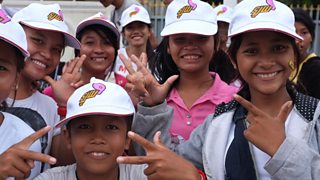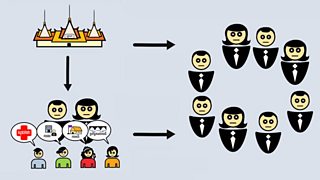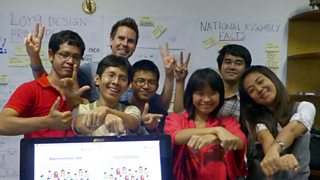Visualising voting in rural Cambodia
Mark Bryson
Creative Director, �������� News, Visual Journalism
Tagged with:
This Sunday, Cambodians will vote in elections to their parliament, the National Assembly. Cambodia has the largest youth population in South East Asia and low levels of formal education. Lots of young people will be of voting age for the first time this year but they are a quiet majority, discouraged from speaking up in public and taking part in civic life.
�������� Media Action's multimedia youth engagement initiative, Loy9, aims to address that by giving young Cambodians information and ideas to help them get involved in life outside their homes and school.

Young Cambodians take place in an event organised by Loy9 in Phnom Penh.
One of the current aims of Loy9 is to explain what their National Assembly is, and this is where I come in. I lead the visual journalism editorial design team that creates information graphics for �������� News on mobile, tablet and PC, and earlier this year, I was invited to mentor the Loy9 team in producing infographics.
Before I knew it I was in Phnom Penh armed with post-it notes, marker pens, and mosquito repellent.
It was an incredible experience to arrive in the searing heat, and swap my normal London commute for a speedy £1 tuktuk ride and my cheese baguette lunch for an amok trey, a delicious fish curry.
But why infographics?
Well, they're great for getting around low literacy which is important for a rural Cambodian audience, who typically watch Loy9 on a small TV that runs off car batteries, and is shared between a few village homes.
They are visually stimulating and can bring order and simplicity even to huge, complex amounts of information – crucial when politics and government are not familiar concepts. They can make that information less threatening and more human in tone. And they're not expensive to produce.
Tutoring by YouTube
When I arrived, I was surprised at the technical ability of the team. While some had formal design training, many of them had taught themselves advanced techniques from YouTube tutorials.
I realised that the most useful thing I could share with the team was my knowledge of the creative process. Among all the YouTube tutorials, you can't really find guidance on the best process to follow to get from a design problem to an effective design.
I explained to the team that I wanted to follow a problem-solving process commonly used in design that draws on what we call "divergent and convergent thinking".
"Divergent thinking" means generating and exploring as many solutions as possible. So the team began by gathering dozens of facts about the National Assembly.
They then "converged" – ie agreed the single best solution – by selecting the few key facts that we would include in the infographic.
The team diverged again by each creating their versions of the graphic, and then converged by deciding on the strongest version.

The team discuss the most important facts to show in the infographic.
Our graphics relied on a range of icons to represent things like school, voters, representatives and the National Assembly. We wanted to be confident the audience understood these icons, so decided to run some user testing.
Testing under trees
The team set off in pairs, managing to interview 30 people despite the legendary wet season rain forcing them to shelter under trees during parts of the interviews.
Now that we had the guidance from the audience, we could converge our design thinking.
We worked up one final sketch of the structure of the graphic and then a final sketch for each of the icons. This formed the basis for the digital version of our graphic that appeared in three TV episodes of Loy9, each of which were viewed by at least 2 million people.

The finished product: part of the infographic as it appeared on screen.
It was great to get the chance to show everyone the process of divergent and convergent thinking, as this process can be applied to help solve any creative challenge; from designing Loy9 T-shirts, to deciding what merchandising campaign to run.
My two weeks with the team were just the first step in the training process. I have continued to make myself available to them, and have kept them up to date with all the important developments in the �������� design teams, and wider infographic design community.
And I enjoyed the experience so much that I returned in February for a couple of weeks, but this time it was a holiday – the post it notes stayed in London!

A very proud team: (from left) Sorthy, Sopheak, me, Chantraboth, Lyna, Sothea, Sonina.
Looking back on my time with the team, I am optimistic the infographics we created can help young Cambodians understand what the National Assembly is and why it matters.
A visually engaging, clear and simple presentation of the key facts, which can be understood even by people who cannot read, has to be one of the best ways to reach this audience.
A picture tells a thousand words no matter where you are in the world!
Related links
Visit the Loy9 .
Follow �������� Media Action on and
